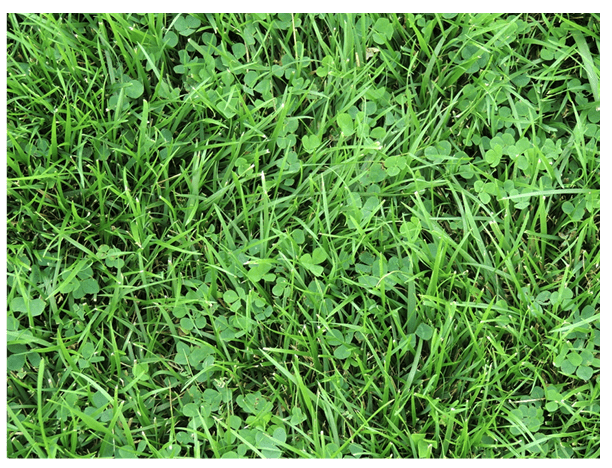White clover or Dutch white clover (Trifolium repens) is a perennial plant, native to Europe, which often shows up in lawns by way of seed dispersal. All clovers are legumes. Through a symbiotic relationship with Rhizobium soil bacteria, legumes are able to transform atmospheric nitrogen gas into an organic form of nitrogen that can be used by plants. Prior to the introduction of broadleaf herbicides in the 1950s, clover was a valued component of lawn seed mixtures for its ability to fix nitrogen, enrich the soil, and improve turfgrass growth. Clover adds diversity to lawns and provides food for bees.
Microclover refers to smaller varieties of white clover (Trifolium repens var. ‘Pirouette’ and ‘Pipolina’). These types have smaller leaves, fewer flowers, and a lower growth habit compared to Dutch white clover. They also have a less aggressive clump-forming habit. Because of these characteristics and their nitrogen-fixing ability, there is interest in using microclover in lawns to enhance turfgrass growth and reduce nitrogen fertilizer applications. Limiting nitrogen runoff is a goal of the Maryland Lawn Fertilizer Law as part of broader efforts to protect the Chesapeake Bay.
The University of Maryland conducted research on microclover used in combination with turf-type tall fescue. There are advantages and disadvantages to its use:
Advantages of microclover
- Mixes well with turf-type tall fescue (and Kentucky bluegrass) and provides a uniform appearance;
- Provides an organic source of nitrogen (in grass clippings and as it decays) to support turfgrass growth; may reduce one nitrogen application per year;
- Flowers provide a food source for bees.
Disadvantages of microclover
- Does not tolerate high heat and drought; starts to die when cool-season turfgrass enters dormancy in the summer; requires reseeding for persistence;
- Top growth dies back in the winter which can leave bare spots and lead to erosion;
- Poor shade tolerance;
- Seeds are expensive and not readily available in retail stores;
- Most broadleaf herbicides labeled for use on tall-fescue will kill microclover;
- Bees attracted to the flowers may be undesirable for people with bee sting allergies;
- Southern blight disease can be a problem occasionally in prolonged periods of high humidity and high nighttime temperatures.
Microclover can be included as a component of lawns, but there is no current research that supports its successful use exclusively as a groundcover or lawn alternative in Maryland.
Additional resources
(PDF) Microclover - Tall Fescue Lawns in the Mid-Atlantic Region, University of Maryland Turfgrass Technical Update, 2015.
Q&A: Pros and Cons of the No-Mow May Movement (addresses the use of clover in lawns) | Maryland Grows Blog
By Christa Carignan, Maryland Certified Professional Horticulturist, Coordinator, University of Maryland Extension Home & Garden Information Center. Reviewed by Dr. Mark J. Carroll, Director, Environmental Science & Policy Program, University of Maryland, April 2019.
Still have a question? Contact us at Ask Extension.
